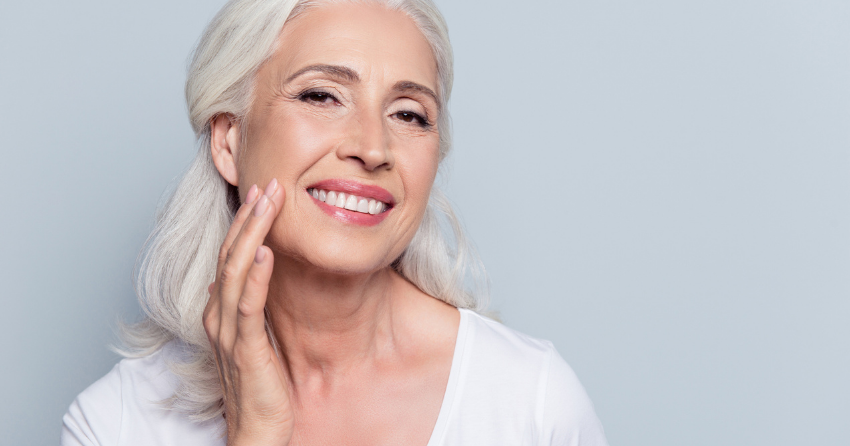Bacteria-Based Cutaneous Care: Strep-Secreted Spermidine Keeps Aging Skin Sleek

The waterproof, flexible, but tough protective covering for our bodies that we call skin is our primary barrier to the external environment. This living surface is littered with populations of microorganisms, the most abundant being bacteria, which affect skin health. Many studies have revealed that the marked changes in the skin microbiome — this cutaneous community of microbes — can alter skin conditions and cause diseases like acne, psoriasis, and atopic dermatitis. But little is known about the role of these bustling bacteria and the rest of the skin microbiome on the aging of the body’s exterior.
New research published by Kim and colleagues from the Gwangju Institute of Science and Technology (GIST) in Korea reported that a bacterial species improved the skin structure and barrier function, thereby contributing to anti-aging. When this research team applied the secretions from specific Streptococcus bacteria, from the same family that can cause “strep throat”, on human skin, there were marked improvements in skin characteristics, such as elasticity, hydration, and peeling. At the root of this, they found, was a secretion called spermidine that contributes to the recovery of skin structure and barrier function.
This recent study shows us that there is much to be learned about the world of microbes on our skin and how they can be harnessed for anti-aging and clinical applications. Kim and colleagues propose, “Our stepwise analysis and findings show that a colonized skin microbiome could improve skin conditions by producing beneficial secretions and suggest that the potential skin microbiome as therapeutic and clinical applications.”

Easy, Breezy, Beautiful Bacteria-Covered Girl
Skin aging is caused by a combination of intrinsic factors, such as changes in hormones, cellular metabolism, and immune responses, and external factors, such as exposure to pollutants and ultraviolet rays. They induce major physiological and physical changes in the skin, such as sagging, wrinkles, dryness, and low elasticity.
The human skin is populated by various microorganisms including fungi, viruses, archaea, and bacteria, which feed on sebum, lipids, and keratin. The most abundant microorganisms are bacteria, which produce several metabolites and affect the proliferation and immune responses of the skin. Changes in the lipid composition, sebaceous secretion, pH, and hydration of the skin during aging can alter the skin microbiome composition which is colonized at birth.
There is some research on the effects of the gut microbiome on skin health. We know that the absorption of probiotics through the intestinal tract has been shown to improve skin health, known as the gut–skin axis. However, studies have only looked at the indirect role of the microbiome in improving skin conditions; direct evidence on the impact of the skin microbiome on skin health should be evaluated.
Saving Your Skin With Spermidine
In this study, Kim and colleagues sought to investigate the direct link between skin health and the skin microbiome in terms of aging. The Korean research team designed a study to identify the components of the skin microbiome and their roles in controlling skin conditions. Analysis of the genomes present in skin samples revealed specific differences in the facial skin microbiome of old and young participants. There were no differences of abundance among the top five most abundant phyla or top 10 genera. They observed that Streptococcus colonies are enriched in the facial skin of young Korean women (20 to 29 years old).
Next, they tested which specific Streptococcus strains could improve skin health, they tested individual candidates on skin cells in lab culture dishes. The secretions of certain Streptococcus species were associated with gene activity that is related to more elastic skin structure, stronger skin barrier, and more moisturized skin. Kim and colleagues believe that the increased activity of these genes related to skin well-being could explain these skin improvements.
To put this into practice, the Korean research team tested the effects of the bacteria on the skin. Kim and colleagues saw that the Streptococcal secretions recovered damaged skin. The bacteria appeared to be doing this by boosting skin structure, barrier function, and characteristics, such as elasticity, hydration, and peeling.
Kim and colleagues pinned down that Streptococcus-secreted spermidine contributed to the recovery of skin structure and barrier function through the upregulation of collagen and lipid synthesis in aged cells. Spermidine is a key precursor in the development of essential fat cells and lipid synthesis, as well as associated with cell viability and autophagy. Here, spermidine increased collagen and elastin, as well as the synthesis of lipids in aged skins. The increased accumulation of lipid in aged cells treated with spermidine confirmed the role of Streptococcal secretions in lipid synthesis and in strengthening the skin barrier function.

Will Bacterial-Based Balms Be The Future of Skin Care?
“Our findings suggest the potential of the Streptococcus species to rejuvenate aged skin, thereby providing insights on the possible applications of the skin microbiome in clinical practice,” concluded Kim and colleagues. But, this study is not without its limitations. The most glaring issue is that the study was restricted to a small population of Korean women. Hence, Kim and colleagues anticipate that further studies including both sexes and people from all around the world will help build links to skin health and skin microbiome. Once we do, you may find yourself bathing in bacterial-based balms to keep your skin looking youthful and beautiful.
References:
Kim G, Kim M, Kim M, et al. Commun Biol. 2021;4(1):231. Published 2021 Feb 19.





